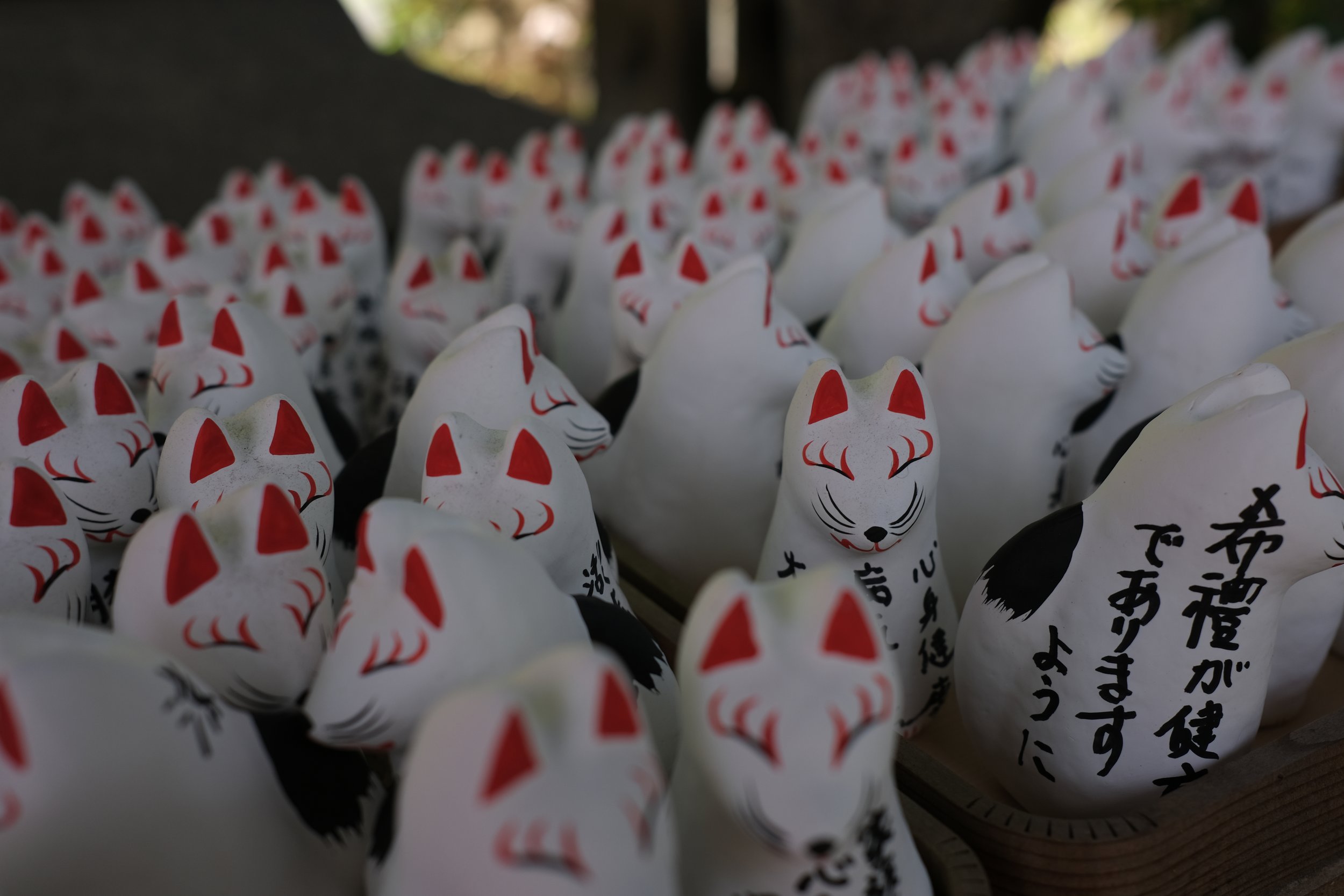Trip Report - Japan | Fukuoka to Osaka
Introduction
Where to begin with our trip to Japan! Simply put: it was incredible. The country has so much to offer: from stunning landscapes, to delicious foods, to friendly people who are always willing to help, despite the language barrier. While we dedicated a whole month to traversing Japan, we only made it from the south to Tokyo, which means we totally missed out on the north of the country and left feeling like we could have spent ages longer along our route.
Fukuoka // Overview
When arriving at the airport, Fukuoka didn’t immediately strike us as a very historical or unique place. This was mostly due to the monotonous gray office buildings and busy multi-lane roads that lay immediately beyond the train station. While this was our initial impression, the city changed our mind and revealed its historical treasures. As we awakened from our sleepy arrival into town, we learned that the city is home to Ichiran’s first ramen shop, which still resides in its rickety little wooden house on an unsuspecting street corner. Not only does Fukuoka boast a strong culinary reputation, but it is also home to some of the country’s most stunning (and not overrun with tourists) temples, where you can quietly watch prayer sessions and observe the intricate detail in the main halls. Alongside the fascinating temples like Tōchō-ji, the city prides itself in preserving their folk history from the Meiji and Taishō eras. This includes detailed recreations of what daily life looked like for the people of Fukuoka. Our highlight in this city was the Fukuoka Castle ruins, originally completed in the Edo period. The Naka River acts as a natural moat to the impressive structure and beautiful cherry blossom trees are sprinkled throughout the grounds that now act as a park.
Fukuoka // Our Favorites:
Hakata Machiya Folk Museum – Not far from the original Ichiran lies the Folk Museum that features detailed recreations of old workshops and crafts from the Meiji and Taishō eras. Here, we learned about Hakata Gion Yamakasa, which is a yearly festival that was started nearly 800 years ago by a Buddhist priest named Shoichi Kokushi. Now, the festival involves the racing of Kakiyama, which are massive festival floats that weigh over a ton! If you’re lucky, you can watch a traditional weaving demonstration by locals.
Shofukuji Temple – Although Japan is absolutely loaded with stunning temples, each is beautiful and different in its own right. This temple was one of our first of the trip and remains one of my favorites. The day we visited was rainy and miserable, but the temple grounds were a wonderfully tranquil place to listen to the rain.
Fukuoka Castle – Fukuoka Castle now acts as a park and very few of the original ruins from the Edo period remain, as they were destroyed by a fire and partially relocated during tumultuous times. Unfortunately, this is a theme you’ll notice at every temple or castle you visit. That said, the structures were rebuilt throughout the years and now offer a beautiful park to enjoy the cherry blossoms.
Coffeeman & Matsupan – You’ll never run out of great coffee spots or bakeries, so it’s the truly incredible ones that leave an impression. In this brilliant cuppa and pastry combo, we first went to Matsupan to pick up some goodies. Matsupan has anything your heart desires, from flakey sweets to savory delights. Next, we walked into the alley next to the bakery and found a spot at Coffeeman, where you’re allowed to enjoy the pastries from next door alongside a carefully crafted coffee. If you’re a coffee bean fanatic, this is the place for you to try hand-dripped coffee made to order based on the roast of your choosing.
RILLBAGEL – New York bagels have rolled their way over the Pacific Ocean and to Japan! Rillbagel was a truly unique spot, all run by a sweet woman who makes everything herself. Our favorite order was the caramel bagel with the apple-cinnamon cream cheese – a real breakfast treat that tastes like apple pie!
Ichiran Ramen – This is the origin spot of the now famous ramen chain that first opened in the Hakata district as a small stall in 1960. The location still stands and serves the familiar vending machine ramen in the small, traditional wooden hut. Options are limited if you have dietary restrictions, but shouldn’t be missed!
Nakasu Yatai (Food Stalls) – Fukuoka comes alive at night and one of the best places to experience it like a local is at the Nakasu Yatai. Here, tiny food stalls line the street along the river that barely have room for 10 people at a time. You’ll have to wait your turn, but you’ll sit side by side with locals as you enjoy excellent food and sip on buzzy sake.
Bar Oscar – This bar is so fun and one of the most recommended spots in Fukuoka. The owner himself, Oscar, served us each drink and even shared some of his favorite sake with us! He provided us with bar snacks and great conversation, despite the language barrier. Please note: bars in Japan charge seating fees and may charge you for additional drinks, even if they seem free!
Hiroshima // Overview
Hiroshima is much more than the devastating nuclear disaster in its history. The city has done an incredible job of recreating itself while preserving the culture and the memories of every life that was lost on August 6th, 1945. Hiroshima has also made it its mission to be a global representative for peace and a voice in the fight to stop nuclear warfare and technological development. It was both moving and impressive to walk through the expansive monuments and parks that now serve as a reminder of that fateful day. Beyond all that the city has rebuilt, it is also the link to the Miyajima Island, an idyllic speck of land in Hiroshima Bay.
Hiroshima // Our Favorites:
Hiroshima Peace Memorial Museum – If you’re looking to learn about the tragedy of the nuclear bombing in Hiroshima, this is the place to go. The museum is huge and displays an extensive collection of belongings collected from victims and their families. Each item on display “embodies the grief, anger or pain of real people”, providing visitors with a tangible and shocking look at the events and aftermath of the A-bomb calamity. The message the city hopes to share with the world with this museum is the need for the “elimination of all nuclear weapons and the realization of a genuinely peaceful international community”. The museum is very up-to-date, with exhibits dating to events from a few months ago, pertaining to nuclear threats from certain countries. Please note: this museum displays very graphic images, so we would recommend some parental guidance when visiting with children.
Hiroshima Peace Memorial Park – The grounds outside the museum are expansive and beautifully kept. There are a number of monuments sprinkled throughout the park, some dedicated to peace, others to entire school groups lost in the explosion. It was beautiful to see the endless paper cranes people had strung up onto the monuments, representing the wish for peace they hope to come true.
A-Bomb Dome – The dome is one of the most iconic sights of Hiroshima and is a raw example of the damage the nuclear bomb caused in 1945. In fact, the dome is one of the few things that wasn’t entirely flattened in the blaze. After the bombing, Hiroshima residents were torn on what to do with the remaining skeleton of the dome, which once was a products exhibition hall. With a vote, the majority eventually decided to keep the building as is. Now, it still stands tall even though the city has grown around it and the cherry blossoms bloom once again on the banks of the Motoyasu River.
Hiroshima Castle – Hiroshima Castle is among one of the most famed castles, originally constructed in the 1590s. While it was destroyed in the bombing in 1945, the rebuilt structures are a gorgeous spectacle, especially with the addition of cherry blossoms in Spring. You can also climb up to the top floor of the main tower to get a great view over the castle grounds and central Hiroshima.
Miyajima Island (Itsukushima) – Just a short ferry ride from the mainland lies Miyajima Island. The island is a bit of a tourist attraction, but if you wander off from the main streets, you’ll discover a quiet and fairytale-like forest town. Right off the ferry, you’ll suddenly find yourself amongst the Sika deer, the island’s only native deer species that are determined to steal your snacks. That said it is, of course, forbidden to pet or feed these animals and better to enjoy the oddity of walking next to them on the street. The main streets bustle with tourists, deer, and street vendors selling traditional, filled leaf-shaped cookies called momiji manju. If you follow the main street, you’ll end up at Omoto Park where a few locals sit below the cherry blossoms for a picnic and the more anti-social deer seek refuge. We spotted plenty of fawns and were able to give each one a little photoshoot without the bother of crowds. Finally, the top attraction of the island is the Itsukushima Jinja, the shinto shrine that boasts the massive floating torii gate known far and wide. At low tide, the sand is crawling with tourists, so be prepared to take a photoshoot masterclass for a good picture. Top tip: stop at Yamaichi Bekkan for homemade sushi bento boxes, even vegetarian ones!
Taiko Udon Nakamachi – I had heard about a great udon noodle spot, where I could get a hearty veggie dish and Jackson could enjoy something with meat. Taiko Udon was incredible and insane at the same time...let me explain. I ordered the Szechuan noodles with plant-based meat and let me tell you, it blew my head off! The pepper tasted hot and almost lemony, leaving my tongue tingly, like pins and needles. Jackson had a great meal too, while I was busy having an out-of-body spice experience. Don’t worry, if you’re not one for spice, Taiko Udon also has plenty of other great meat and vegetarian/vegan options!
Okonomiyaki Nagataya – Okonomiyaki reportedly originated from Hiroshima, although it's a very different style to what you’ll find in other cities. Generally, it’s a mishmash of egg, ramen noodles, green onion, cabbage cheese, and some sort of seafood, meat, or veggie topping. In Hiroshima, the egg is fried and sandwiches the rest of the ingredients together, rather than being whisked into the cabbage beforehand. This means even I can have it in Hiroshima since the egg is easy to remove, unlike at many other Okonomiyaki restaurants in Japan.
Okayama // Overview
Okayama feels like a pretty bare city when arriving at the station, much like Fukuoka. That said, the little streets beyond there invite more of a historical feel to the city with traditional buildings and scattered shrines. While Okayama is worth exploring, there are a number of attractions outside of town that are fairly easily accessible with public transport.
Okayama // Our Favorites:
Naoshima Art Island – This place feels otherworldly! We took the bus out early from Okayama and transferred to a very tiny ferry to reach the island. The island has loads of exhibitions and outdoor sculptures to explore, including works by Claude Monet and Yayoi Kusama. Not only is the art mesmerizing on its own, but the landscape brings it to life with the elements. We didn’t have too much time, but we’d recommend taking at least one full day to discover it all.
Kibiji Biking Trail – If you’re in the mood for some outdoor fun, the Kibiji cycling trail is for you! The trail begins at Bizen-Ichinomiya station, where you’ll pick up your bike(s) from a mom and daughter duo who speak very little English. These ladies supplied us with a map that took us through little streets and over rice paddies, noting stops we could make along the way. The first stop was the Kibitsu Jinja shrine that boasts a large pagoda and a peaceful garden. You’ll find plenty of burial mounds along the route too, which are conceptually fascinating, just not much of an interesting site from the ground. This ride is definitely a great way to spend time in the Japanese countryside – you’ll see farmers tending to their peach trees, kids playing in the fields, and in springtime plenty of blossoms painting the landscape pink.
Okayama Gardens – The gardens in Okayama rank among the top three in the country and are best to be enjoyed on a sunny day. The day we went, we walked through the gardens in pouring rain, which we thought actually added something mysterious to a typically idyllic landscape. While we found other gardens more interesting, we truly enjoyed the sprawling, perfectly manicured, green, and intricate waterways.
Okayama Castle – As mentioned, you may find that the castles you visit in Japan aren’t the original builds, mostly thanks to the fires that ravaged over the years. While Okayama Castle is one of those that has unfortunately been rebuilt, the park surrounding the main tower is definitely worth an exploration, with good views of the Asahi river and Okayama Gardens on the other side.
Himeji Castle – This castle is the largest castle in Japan and was definitely one of the biggest trip highlights for Jackson and I! We decided to take the train from Okayama to make a stop there before continuing on to Kobe. While it was a bit of a detour, the castle is entirely worth a visit because of how much time you need to walk through its expansive buildings and gardens. Unlike most castles in Japan, many of the original buildings still stand from the 1609 expansion of the grounds and the gardens absolutely explode with cherry blossoms in the Spring.
Kobe // Overview
Kobe: the home of the famous beef! Locals here won’t let you forget where the iconic beef comes from, especially as every restaurant boasts that they sell the best cut in town. While Kobe is a very beef-focused city, it also has a stunning waterfront, tranquil hilltop shrines, and an unexpected district with a European influence.
Kobe // Our Favorites:
European Village – This area of Kobe was once home to a large group of European settlers, who were required to live in a separate area to the locals. As the city grew and attitudes changed, this area merged with the surrounding city and is now an interesting place to explore due to its British, French, and German-style homes. We didn’t find the actual European Village as interesting (much of it was recreated), but we did find some hidden gems as we made our way up the hill. More below…
Kitano Tenman Shrine – This was one of the most memorable shrines we visited, at least in my opinion! At its base, the shrine invites you in with a torii gate and the endless stairs beyond that take you up to the central shrine. Once you’ve conquered the steep stairs, you’ll be rewarded with a quiet temple lined with cherry trees and surrounded by glorious city views.
Le Croissant De Vacances – Coffee and pastries are always a good idea. Le Croissant De Vacances is the ideal spot for a good cuppa and a crunchy-on-the-outside-and-squishy-on-the-inside kind of pastry.
Kobe Entrecote – Choosing a spot to try Kobe beef that also had a vegetarian option was a struggle, but based on local recommendations, we ended up at Kobe Entrecote. The entrance was tough to find, as there’s a mere sign in an alcove of the building that guides you upstairs to the fourth floor. Once there, the room opens up to a long Teppan table, where you’ll watch the experts prepare your meal. The food was incredible and (according to the meat-eaters of the group) the beef was cooked perfectly. As half of us were vegetarian in this outing, it was refreshing for the chef to prepare specialty tofu and veggies for us too! We would definitely recommend this place!
Osaka // Overview
Osaka is a hub for wider attractions, with tourists even taking day trips out from Tokyo. While this isn’t an impossible task, we’d recommend taking a few days to see Osaka, as many of its most unique sights are far to reach. When we heard it was half the size of Tokyo, we thought it would be easy to get around but as the city is still larger than New York City, it can take a while to move to different parts of town. Much like Tokyo, Osaka boasts several different areas that feel like they could be the center of town, with enough of these areas to explore to take up several days and nights.
Osaka // Our Favorites:
Osaka Castle – Osaka Castle is a much more touristy attraction than other castles we visited, but it is worth seeing the dense cherry blossoms that grow along the moat and surrounding park. In late Spring invites the blossoms to fall like snow! We didn’t feel the need to go into this castle as it was recently rebuilt and the interior resembles a simple, sterile modern office building.
TeamLab at Osaka Botanical Gardens – We had heard of TeamLab before coming to Japan and made it our mission to go to all of their exhibitions. Osaka’s Teamlab exhibit was all outdoors in the botanical gardens, which poses as a unique space for the light shows and glowing objects we encountered. Somehow, the man-made art merged perfectly into the natural landscape, immersing you in the artistic world they’ve created.
Shittenoji Temple – Another truly unique temple! The grounds are home to a very impressive pagoda that climbs five stories and stands tall in the middle of a rock zen garden. We were lucky to watch a special ceremony there that involved the Abbot of the temple and two of his monks. Their chants were mesmerizing, transporting us far away from reality. The gardens at the temple may seem hidden and small, but it was very special to walk through the blossoming trees and watch the petals pool in the streams that weave below.
Shinsekai – Shinsekai is the ‘retro’ part of town, where you can walk the brightly-lit streets that are adorned with massive lights, billboards, and figurines. Originally built as a vision of the future in 1912, the neighborhood is a look ‘back to the future’ and is like stepping into the world of Blade Runner or Robocop. Not only is it a great photo spot at night, but the arcades are a fun way to win some prizes!
Dontonburi – This is another night-time spot, but is much more crowded compared to Shinsekai. It feels as if all of Osaka walks these streets in search of food stall snacks, bars, and shops. I had the single best strawberry I’ve ever had here!
Melbourne Coffee – it can be tough to find good breakfast spots in Japan, as they frequently open very late (11am or 12pm). So, finding Melbourne Coffee was a victory because they open fairly early (9 am) and serve hearty Aussie dishes. While we giggled at the silliness of eating at an Aussie eatery just after leaving OZ, we found comfort in their toasties and granola bowls.
La Pizza Napoletana Regalo – Eating pizza in Japan sounds…strange, right? Actually, it’s not! Tomohisa Niizoe, the owner of La Pizza Napoletana Regalo, entered the World Pizza Championship in Naples, going up against literal Italians, and WON! On a day-to-day basis, Tomohisa operates out of his small restaurant, which houses a large pizza oven and walls lined with signed dollar signs. While this spot may come with a bit of a wait, the pizza is so worth it! Once seated and ordered, your pizza arrives within minutes, even though Regalo is a one-man-show! The pizza itself is perfectly thin, doused in juicy marinara, and topped with deliciously simple mozzarella.
Ten Carat Tempura – Tempura is another food that exists in great abundance, but Jackson’s dad swears he had the best experience at Ten Carat. The restaurant is run by a couple, who, despite being endlessly busy, do their best to make everything in a timely fashion. The tempura is perfectly light and crunchy – apparently the salmon with garlic butter was the best!
Where We Stayed:
Fukuoka
Hiroshima
Okayama
Kobe
Osaka






















































































